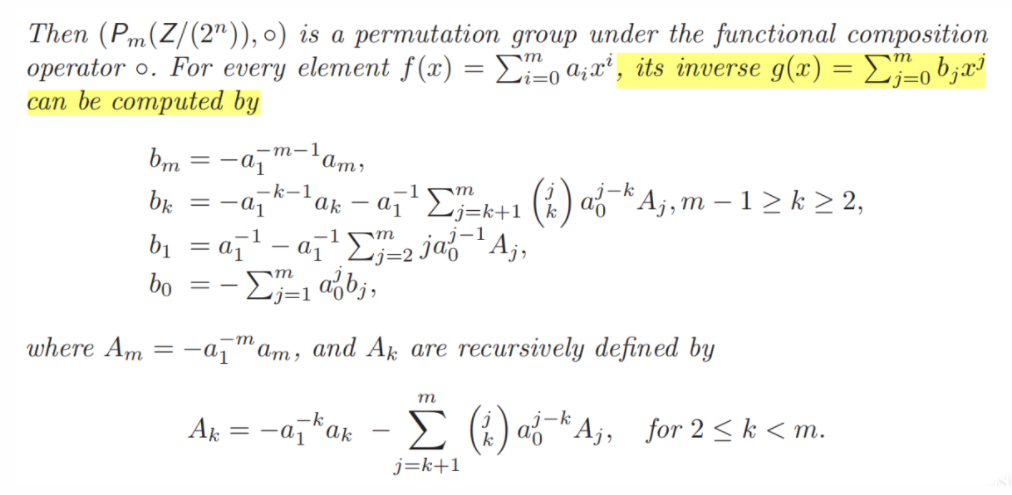多项式MBA原理及其在代码混淆中的应用


本文为看雪论坛优秀文章
看雪论坛作者ID:34r7hm4n
MATH WARNING: 本文涉及少量抽象代数知识,基本上都是网安专业信安数学必修课中学到的内容。推荐这篇文章《代数结构入门:群、环、域、向量空间》(https://zhuanlan.zhihu.com/p/21583674),总结得很好。
1
基本概念

定义集合Pm上的运算◦,◦即函数复合,例如f(x)◦g(x)=f(g(x))。集合Pm与运算◦构成一个群:

对于Pm中的多项式f(x),一定存在一个g(x),使得f(x)与g(x)满足f(x)◦g(x)=x或者说f(g(x))=x。g(x)可以通过以下公式来求解:

2
多项式求逆C语言实现
用到的有以下几个运算:求逆、求组合数、次方、相乘、求和、取反。这些运算都是在Z/(2^n)上的,也就是说运算结果都要模2^n。可以用flint2这个库来实现,代码如下:
#include "flint/fmpz_mod_poly.h"#include "flint/flint.h"#include <time.h>#include <cstdio>#include <cstdint>#include <iostream>using namespace std;int factorial(int n){int fc=1;for(int i=1;i<=n;++i) fc *= i;return fc;}int combo(int n,int m){return factorial(n) / (factorial(m) * factorial(n-m));}fmpz** gen_poly(int degree){fmpz_mod_ctx ctx;fmpz n = 1LL << 32;fmpz_mod_ctx_init(&ctx, &n);fmpz_mod_poly_struct f, g;fmpz_mod_poly_init(&f, &ctx);fmpz_mod_poly_init(&g, &ctx);fmpz m = degree;fmpz *a = new fmpz[m + 1];fmpz *b = new fmpz[m + 1];fmpz a1_inv;fmpz *A = new fmpz[m + 1];fmpz *A_sum = new fmpz[m + 1];a[0] = rand(), a[1] = rand() | 1;for(int i = 2;i <= m;i ++){a[i] = (rand() >> 16) << 16;}// Calculate a1_invfmpz_mod_inv(&a1_inv, a + 1, &ctx);// Calculate Afmpz_mod_pow_ui(A + m, &a1_inv, m, &ctx);fmpz_mod_neg(A + m, A + m, &ctx);fmpz_mod_mul(A + m, A + m, a + m, &ctx);for(int k = m - 1; k >= 0;k --){fmpz sum = 0;for(int j = k + 1;j <= m;j ++){fmpz tmp;fmpz_mod_pow_ui(&tmp, a, j - k, &ctx);fmpz_mod_mul(&tmp, &tmp, A + j, &ctx);fmpz_mod_mul_ui(&tmp, &tmp, combo(j, k), &ctx);fmpz_mod_add(&sum, &sum, &tmp, &ctx);}fmpz_mod_pow_ui(A + k, &a1_inv, k, &ctx);fmpz_mod_mul(A + k, A + k, a + k, &ctx);fmpz_mod_neg(A + k, A + k, &ctx);fmpz_mod_sub(A + k, A + k, &sum, &ctx);A_sum[k] = sum;}// Calculate bmfmpz_mod_pow_ui(b + m, &a1_inv, m + 1, &ctx);fmpz_mod_neg(b + m, b + m, &ctx);fmpz_mod_mul(b + m, b + m, a + m, &ctx);// Calculate bkfor(int k = 2;k < m;k ++){fmpz_mod_pow_ui(b + k, &a1_inv, k + 1, &ctx);fmpz_mod_mul(b + k, b + k, a + k, &ctx);fmpz_mod_neg(b + k, b + k, &ctx);fmpz tmp;fmpz_mod_mul(&tmp, &a1_inv, A_sum + k, &ctx);fmpz_mod_sub(b + k, b + k, &tmp, &ctx);}// Calculate b1fmpz sum = 0;for(int j = 2;j <= m;j ++){fmpz tmp;fmpz_mod_pow_ui(&tmp, a, j - 1, &ctx);fmpz_mod_mul(&tmp, &tmp, A + j, &ctx);fmpz_mod_mul_ui(&tmp, &tmp, j, &ctx);fmpz_mod_add(&sum, &sum, &tmp, &ctx);}fmpz_mod_mul(&sum, &sum, &a1_inv, &ctx);fmpz_mod_sub(b + 1, &a1_inv, &sum, &ctx);// Calculate b0b[0] = 0;for(int j = 1;j <= m;j ++){fmpz tmp;fmpz_mod_pow_ui(&tmp, a, j, &ctx);fmpz_mod_mul(&tmp, &tmp, b + j, &ctx);fmpz_mod_add(b, b, &tmp, &ctx);}fmpz_mod_neg(b, b, &ctx);fmpz **coeff = new fmpz*[2];coeff[0] = a, coeff[1] = b;delete[] A;delete[] A_sum;return coeff;}int main(){int degree = 10;srand(time(NULL));fmpz** coeff = gen_poly(degree);fmpz_mod_ctx ctx;fmpz n = 1LL << 32;fmpz_mod_ctx_init(&ctx, &n);fmpz_mod_poly_struct f, g, res;fmpz_mod_poly_init(&f, &ctx);fmpz_mod_poly_init(&g, &ctx);fmpz_mod_poly_init(&res, &ctx);for(int i = 0;i <= degree;i ++){fmpz_mod_poly_set_coeff_ui(&f, i, coeff[0][i], &ctx);fmpz_mod_poly_set_coeff_ui(&g, i, coeff[1][i], &ctx);}fmpz_mod_poly_compose(&res, &g, &f, &ctx);flint_printf("f(x) = "); fmpz_mod_poly_print_pretty(&f, "x", &ctx); flint_printf("\n");flint_printf("g(x) = "); fmpz_mod_poly_print_pretty(&g, "x", &ctx); flint_printf("\n");flint_printf("g(f(x)) = "); fmpz_mod_poly_print_pretty(&res, "x", &ctx); flint_printf("\n");}
f(x) = 1756102656*x^10+947978240*x^9+368902144*x^8+1950089216*x^7+497156096*x^6+1583087616*x^5+178454528*x^4+202440704*x^3+932052992*x^2+421111353*x+593005452g(x) = 2268332032*x^10+395247616*x^9+2160525312*x^8+2187591680*x^7+3999137792*x^6+833880064*x^5+806682624*x^4+1138688000*x^3+2095448064*x^2+3762448393*x+1736062996g(f(x)) = x
fmpz_mod_ctx ctx;fmpz n = 1LL << 32;fmpz_mod_ctx_init(&ctx, &n);
#include "flint/fmpz_mod_poly.h"#include "flint/flint.h"#include "z3++.h"#include <time.h>#include <cstdio>#include <cstdint>#include <iostream>using namespace std;using namespace z3;uint64_t inverse(uint64_t n){context c;solver s(c);expr a = c.bv_val(n, 64);expr a_inv = c.bv_const("a_inv", 64);s.add(a * a_inv == 1);s.check();model m = s.get_model();return m.eval(a_inv).get_numeral_uint64();}void gen_univariate_poly(uint64_t *a, uint64_t *b){uint64_t a0, a1, b0, b1, a1_inv;a0 = ((uint64_t)rand() << 32) | rand(), a1 = ((uint64_t)rand() << 32LL) | (rand() | 1);// Calculate a1_inva1_inv = inverse(a1);// Calculate b1b1 = a1_inv;// Calculate b0b0 = -(b1 * a0);uint64_t **coeff = new uint64_t*[2];a[0] = a0, a[1] = a1, b[0] = b0, b[1] = b1;}
3
混淆思路

生成一对互逆的一次多项式f(x)和g(x)
构造与x+y等价的线性MBA表达式E2=(x^y)+2*(x&y)(关于什么是线性MBA表达式见我的上一篇文章)
构造E3=g(f(E2)),由之前提到过的性质,g(f(E2))实际上就等于E2
用等价但更复杂E3表达式替代原x+y表达式
4
LLVM Pass实现
Github:
MBAObfuscation.cpp
MBAUtils.cpp
首先是把求逆多项式的代码移植一下,跟之前区别不大:
uint64_t inverse(uint64_t n, uint32_t bitWidth){context c;solver s(c);expr a = c.bv_val(n, bitWidth);expr a_inv = c.bv_const("a_inv", bitWidth);s.add(a * a_inv == 1);s.add(a_inv != 0);s.check();model m = s.get_model();return m.eval(a_inv).get_numeral_uint64();}void generateUnivariatePoly(uint64_t *a, uint64_t *b, uint32_t bitWidth){uint64_t a0, a1, b0, b1, a1_inv;a0 = cryptoutils->get_uint64_t(), a1 = cryptoutils->get_uint64_t() | 1;// Calculate a1_inva1_inv = inverse(a1, bitWidth);// Calculate b1b1 = a1_inv;// Calculate b0b0 = -(b1 * a0);a[0] = a0, a[1] = a1, b[0] = b0, b[1] = b1;}
Value* llvm::insertPolynomialMBA(Value *linearMBAExpr, BinaryOperator *insertBefore){IRBuilder<> builder(insertBefore->getContext());builder.SetInsertPoint(insertBefore);Type *operandType = insertBefore->getOperand(0)->getType();uint32_t bitWidth = operandType->getIntegerBitWidth();uint64_t a[2], b[2];generateUnivariatePoly(a, b, bitWidth);Value *expr;expr = builder.CreateMul(ConstantInt::get(operandType, b[1]), linearMBAExpr);expr = builder.CreateAdd(expr, ConstantInt::get(operandType, b[0]));expr = builder.CreateMul(ConstantInt::get(operandType, a[1]), expr);expr = builder.CreateAdd(expr, ConstantInt::get(operandType, a[0]));return expr;}
void MBAObfuscation::substituteAdd(BinaryOperator *BI){int64_t *terms = generateLinearMBA(TermsNumber);terms[2] += 1;terms[4] += 1;Value *mbaExpr = insertPolynomialMBA(insertLinearMBA(terms, BI), BI);BI->replaceAllUsesWith(mbaExpr);}
5
混淆效果
#include <cstdio>#include <cstring>#include <cstdlib>char *input;char enc[100] = "\x86\x8a\x7d\x87\x93\x8b\x4d\x81\x80\x8a\\x43\x7f\x49\x49\x86\x71\x7f\x62\x53\x69\x28\x9d";void encrypt(unsigned char *dest, char *src){int len = strlen(src);for(int i = 0;i < len;i ++){dest[i] = (src[i] + (32 - i)) ^ i;}}//flag{s1mpl3_11vm_d3m0}int main(int argc, char *argv[]){printf("Welcome to LLVM world...\n");if(argc <= 1){printf("Input your flag as an argument.\n");return 0;}input = argv[1];printf("Your flag is: %s\n", input);unsigned char dest[100] = {0};encrypt(dest, input);bool result = strlen(input) == 22 && !memcmp(dest, enc, 22);if(result){printf("Congratulations~\n");}else{printf("Sorry try again.\n");}}


看雪ID:34r7hm4n
https://bbs.pediy.com/user-home-910514.htm

# 往期推荐


球分享

球点赞

球在看

点击“阅读原文”,了解更多!
[广告]赞助链接:
关注数据与安全,洞悉企业级服务市场:https://www.ijiandao.com/
让资讯触达的更精准有趣:https://www.0xu.cn/
 关注KnowSafe微信公众号
关注KnowSafe微信公众号随时掌握互联网精彩
- Strapi 开源且高度可定制的CMS
- 基于高通沉浸式家庭联网平台打造,中国联通智能路由器VS017正式上市
- 自由软件基金会正在衰亡,亟待革新!
- 高通2023暑期实习生项目丨等待发光的你 一起为梦想摇旗呐喊
- 颠覆了计算机格局的“牵牛星” | 历史上的今天
- 不止于轻便,高通aptX让无线音频媲美有线音频
- 又拍云携手厚德云推出海外专场活动,新客 0 元享!
- 偷窃他人漏洞报告变卖成副业,漏洞赏金平台出“内鬼”
- 华为拿百亿资金给员工分红,每股1.58元;苹果将推出M2芯片入门级MacBook Pro;Flutter 2.10发布|极客头条
- 2021网络安全行业高速增长,星阑科技API安全赛道独树一帜
- 30%手机受影响!高通芯片再现高危漏洞
- 三个锦囊:剖析 5G 安全难题
赞助链接










